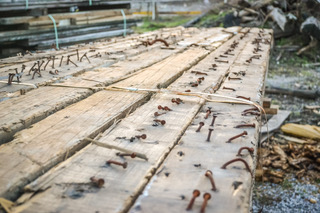
Reclaimed wood usually comes to us in great need of TLC and elbow grease before it can begin to resemble the inspirational products we offer. The process of taking dilapidated, forgotten wood and repurposing it to give it new life is not for the faint of heart.
Before the wood ever hits the kiln to be dried, the planer to be shaped, or the saw to be cut, it must be cleaned, cleared, and denailed. This is not just tapping down a few nail heads that have poked their way out from their flush, 100-year-old resting place. This is a craft that involves diligence, patience, attention to detail, physical and mental strength, and a plethora of tools.
A simple Google search for �denailing� turns up a long list of How-to�s. From DIY-ers� failure stories to seasoned woodworkers� tried and true methods, there are no shortage of opinions or advice for how to approach it and what tools to use. Special hammers, grinders, crow bars, and metal detectors make up the toolbox. People have invented tools to help the process along. But there is no shortcut to the patience and focus this process requires. One by one, with the dedication to do it right, our denailer removes old, rusty metal so that we can turn wood away from landfills and back into service for people who appreciate the history and sustainability of reclaimed wood products.
Once the metal is gone, the warmth and significance of the material begins to shine, revealing the promise of the product.